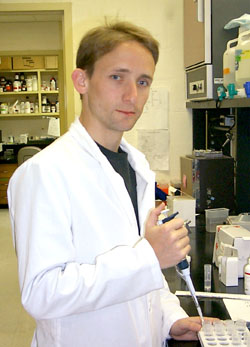
Colin Riordan
Plastic surgery fellow gets national attention
In the short time that plastic surgery research fellow Colin Riordan spent in Nashville, he was able to accomplish a lot, winning three national awards.
Last July, Riordan left his native Ireland to work in the lab of Lillian Nanney, Ph.D., professor of Plastic Surgery and Cell Biology. And work he did. During the year that Riordan spent at Vanderbilt, he completed four different research projects.
“There is so much scope for research in plastic surgery,” Riordan said. “Having a plastic surgery fellowship is a tremendous benefit to the fellow and the university.”
But Riordan’s success didn’t stop there. Three of his projects received national recognition as Riordan won three awards in the past four months.
“It is quite extraordinary to work on four unrelated topics and develop them to such an extent that three out of the four receive national acclaim,” Nanney said. “All of our previous research fellows have had a single-minded focus during their time in the lab.”
According to Riordan, the most prestigious award he received was the Ortho-McNeil Young Investigators Award, which was presented to him and three others in May at the annual national meeting of the Wound Healing Society in Albuquerque, New Mexico.
Winners were selected in advance based on scores assigned by a committee that reviewed applicants’ abstracts.
Riordan’s entry described a woundhealing project on which he spent the bulk of his time in the lab. In this project, Riordan studied the matrix metalloproteinase levels in chronic and denervated wounds that plague paraplegic patients.
Matrix metalloproteins are enzymes that have been implicated in the pathogenesis of non-healing wounds. Riordan studied alterations in the levels of these enzymes after surgical debridement of these wounds.
“If we can get a better understanding of what can remove these enzymes, there may be therapeutic benefits, such as helping these wounds to heal,” Riordan explained.
In May, Riordan also traveled to New York where he became the recipient of the American Society for Aesthetic Plastic Surgery’s Gasper W. Anastasia Award for Best Resident Paper. His presentation, sponsored by Dr. R. Bruce Shack, professor and chair of Plastic Surgery, described an approach that decreased unwanted, thick capsules that frequently form around breast implants. In addition to receiving a cash prize, he was also asked to repeat his presentation at the society’s plenary session attended by several thousand surgeons.
Riordan’s third honor came during a trip to Orlando when he received the Southeastern Society of Plastic and Reconstructive Surgeons’ Glancy Award, becoming the third VUMC Plastic Surgery resident in three years to win it. The Glancy Award is “presented to the resident and residency program deemed to have presented the finest paper in the residency competition at the annual meeting.”
In his presentation in Orlando, Riordan described his third research endeavor. For this project, Riordan and mentors Dr. Sean Wolfort, assistant professor of Plastic Surgery, and Nanney dissected 55 cadavers’ legs in the anatomy lab to look at the blood supply to the sural nerve to see if it would be suitable as a vascularized nerve graft. Riordan said that he hoped to determine whether these nerves could be used as donors because there are often problems finding donor nerves.
Riordan’s fourth and final project involved a study of acute wounds and their blood flow on burn victims.
Riordan returned to Ireland at the end of June to complete his plastic surgery residency at the Royal College of Surgeons in Dublin. In the future, he said he hopes either to return to the United States or to go to Australia for a clinical fellowship after he has finished his training.













